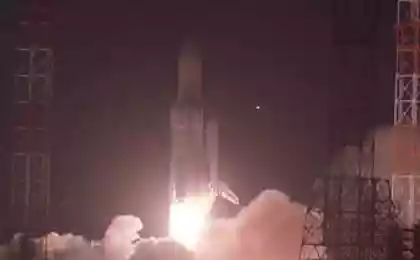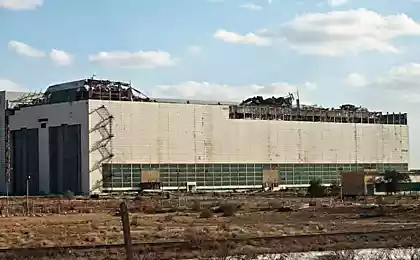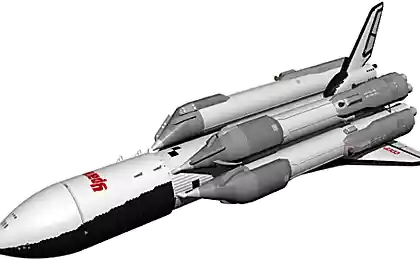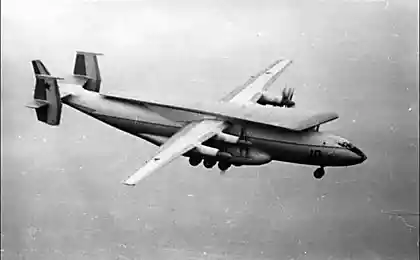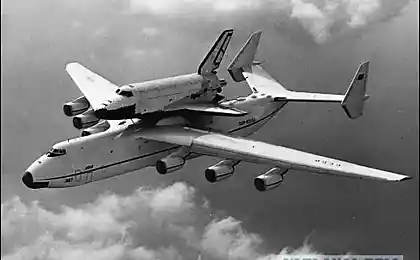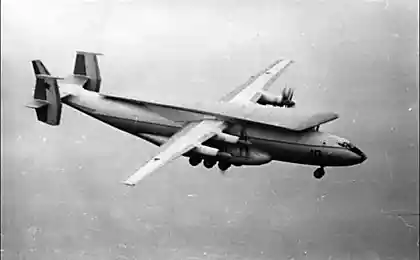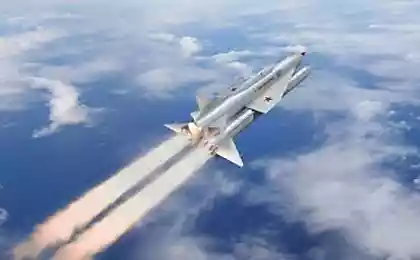1842
25th anniversary of the Buran
November 15 marked the 25th anniversary of the triumph of the Soviet space program - fully automatic flight Space Shuttle Buran. Chronicle of events .
In 1976, the Soviet Union in secrecy began to develop Space Shuttle Buran project "Buran-Energia".
It was an ambitious project. In its creation was attended by 86 ministries and departments and enterprises of the USSR in 1286 (about 2, 5 million people)
His first and only space flight "Buran" made November 15, 1988. Orbiter was launched c Baikonur Cosmodrome using rocket "Energy". After the flyby of the Earth Buran made a landing on the airfield a specially equipped "Jubilee" at Baikonur. The flight went without a crew, a fully automatic mode. In contrast to the American Space Shuttle, which makes landing only on manual control.
More details about himself Buran can be found at Wikipedia. But the most complete information is collected on the website http://www.buran.ru
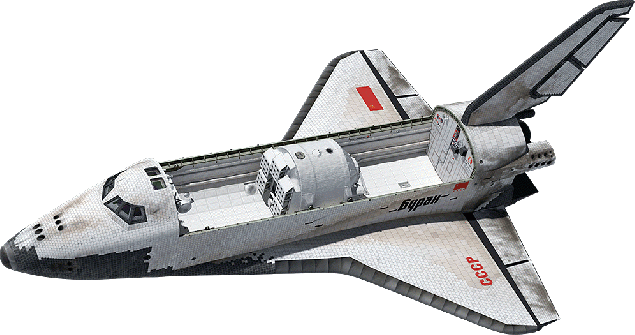
Ground control, which is the nerve center of the DRM in the first flight "Buran" put six monitoring stations, four floating stations and systems and data communications, consisting of a network of terrestrial and satellite broadband and telephone channels. To manage the process of planting, in addition to the ground-based monitoring and control, use your own digital computer (on-board digital computer) "Burana" "Beads-4." Military order defined architecture FDC - it has been implemented in the form of four parallel independent computing channels and a comparator which continuously compares the result to the output channels. In case of rejection of the results of any of the channels from the other three, it disables the onboard computer and went to work as usual. In the same way could be off another damaged computing channel, thus achieving automatic redundancy and fault tolerance of onboard computer. Computing channels (or nucleus, in modern terminology) operates at a frequency of 4 MHz and had 128 KB of RAM and 16 Kbytes of program memory constant
a little bit more about the onboard computer 1. Computer system Burana consisted of two systems:
- The central computer system consisting of 4-FDC-type beads 4.
- Peripheral computing system consisting of 4-FDC-type beads 4.
2. The names of the "central" and "peripheral system is in some sense arbitrary, since they were exactly the same.
3. Four types of digital computer Beads-4 operate synchronously, on the same program.
It was a four-fold hardware rezervirovnie. When any two control system failure Burana was to provide mission-critical tasks: saving the lives of the crew and return to Earth Burana.
4. In contrast to the Americans who use the software to synchronize the four onboard computer (on-board computers), we used a hardware-timed four BTsVM type Beads-4. Was developed for this five-fold redundant crystal oscillator output frequency pretending scheme voting three out of five (3 of 5). This ultra-reliable crystal oscillator (five channels which were, of course, synchronized with each other) vydavyval frequency simultaneously on all 4 types of digital computer Beads-4.
5. From the outset, in a huge bookcase, which houses the instruments on board were provided Burana 8 seats, which can be "pushed into" 8 BTsVM type Beads-4.
4. The first (and only) Buran used only central computer system (only 4 FDC-type beads 4). O system was not used. This means that are inserted into the bookcase unit 4 only 4-Beads. The remaining 4 seats for the four onboard computer peripheral systems were empty and closed with plugs.
5. In the second start Burana (which never took place) number of flight problems increased. Power one of four onboard computer was not enough and in the composition of the instrument control system was reintroduced O system, that is, added another four BTsVM type beads.
6. Preparations for the second launch of the Buran was in full swing. But the collapse of the Soviet Union led to the cessation of work.
7. What about the language of dragons. Here it is necessary to speak in great detail. But I will confine one mention.
Consider the problem of conservation management survivability fourfold rezerirovannoy four BTsVM Beads-4 in case of failure of one, two and three digital computer. On the part of this task can seem pretty simple. In fact it is not. To solve this problem was provided for the program, which was called the PPN (reliability improvement program). This program was developed in my laboratory Larisa Turin. It was developed at the dragon. But then it was a "paper" Dragon. In fact, it was a detailed algorithm for the dragon. Larissa gave it to programmers and they coded it to asseblere BEADS-4.
Taken here
In developing Burana problem of developing and testing of the software was considered one of the most difficult. Initially it was assumed that the solution would require several thousand programmers.
The software was created in the Research and Production Center of Automation and Instrument Academician NA Pilyugina and the Institute of Applied Mathematics. MV Keldysh.
After studying the problem, it was decided to develop a problem-oriented languages, based on the terms, concepts and presentation of control algorithms and testing of the ship used by developers. Implementation of these languages will involve the creation of on-board and test the software developers themselves of the ship - the authors of control algorithms and testing. Development of language and related tools has been performed by a small team of highly skilled programmers Institute of Applied Mathematics in extremely short time.
For the development of flight software was created specialized language real time PROL2 and based on it automation system programming and debugging SAPO PROL2. For the operation of control algorithms was created onboard operating system, successfully operated during the first unmanned flight of the ship.
Software development of ground tests of the ship was created problem-oriented language based on the dipole and it automation system programming and debugging. For the operation of testing algorithms was created automated test system ...
In addition, Pilyuginskom center under the direction of Konstantin Fedorov was developed for the simulation language LAX.
Over time, it became clear that the abundance of languages prevents the case. There was a proposal to replace these three languages on one universal language - DRAGON (Algorithmic friendly Russian language, which provides a descriptive).
The dragon was created gradually, in three stages. B> Step 1: In 1984, in the center was designed Pilyuginskom language Phlox (as part of the declarative language PROL2 describing the terms and concepts used in the design of control algorithms and testing of the ship used by developers Buran). In addition, the database was created Phlox.
Authors languages Phlox was Vladimir Parondzhanov.
The author of a database - Vladislav Baltrušaitis.
Developers algorithms were given the task programmers to develop programs in PROL2 as a partially formalized flowcharts provided with phlox phlox identifiers and descriptions.
These flowcharts are simplified prototype of the dragon language. But the name of the Dragon at that time still was not used.
Step 2. Add the unexpected situation. For the same concepts Burana languages PROL2, Dipole and LAX had different system identifier that was extremely uncomfortable.
It soon became clear that the phlox identifiers has an unconditional benefits. Consequently, the dipole-IDs and LAX-identifiers were dropped completely useless. Phlox identifiers won a complete and final victory.
Step 3. Unity identifiers in three languages (PROL2, dipoles LAX) gradually led to the proposal to waive the three languages and replacing them with a single universal language.
This idea was expressed in 1986 by the chief of department of complex Yuri Trunov (later General Designer and Director General Pilyuginskogo center).
Trunov ordered the creation of a new language, the head of the laboratory of the complex development of a computer system Burana Vladimir Parondzhanovu.
Began a gradual transformation of partially formalized Block Diagram (which were used as input for the development of programs in PROL2) in a strictly formal language, called Dragon.
Development of language and his Dragon software lasted for about 10 years (1986-1996). During this time, technology was created to develop algorithms and programs "graph-Phlox"
All work on the system graph-FLOKSbyli completed by 1996. Then she went into operation.
With the help of developed algorithms and programs Sea Launch project. In total, the development and testing of software and other elements of the project "Sea Launch" took three years.
DRAGON is not a dead language. It is used mainly in the space industry. Used to create software for the Phobos-Grunt, the upper stage "Fregat" modernization rocket "Proton-M". Used in the NPO. Lavochkin to build the lunar module.
Let's dwell on the features of the language DRAGON:
1. DRAGON - graphical (visual) language.
2. Rigid standardization allows for flowcharts to synthesize the program code.
3. The language is very easy and well thought out. Ground on practical problems.
4. It is much easier to UML. We can say that the UML - for object-oriented programming, and Dragon schema for procedural programming.
In order not to engage Crossposting I leave a link to the Wiki with a brief description language.
All material taken from the site:
http://www.buran.ru/
http://drakon.su/
http://forum.oberoncore.ru/
http://transhumanism-russia.ru/
http://ru.wikipedia.org/
Source: habrahabr.ru/post/202332/
In 1976, the Soviet Union in secrecy began to develop Space Shuttle Buran project "Buran-Energia".
It was an ambitious project. In its creation was attended by 86 ministries and departments and enterprises of the USSR in 1286 (about 2, 5 million people)
His first and only space flight "Buran" made November 15, 1988. Orbiter was launched c Baikonur Cosmodrome using rocket "Energy". After the flyby of the Earth Buran made a landing on the airfield a specially equipped "Jubilee" at Baikonur. The flight went without a crew, a fully automatic mode. In contrast to the American Space Shuttle, which makes landing only on manual control.
More details about himself Buran can be found at Wikipedia. But the most complete information is collected on the website http://www.buran.ru

Ground control, which is the nerve center of the DRM in the first flight "Buran" put six monitoring stations, four floating stations and systems and data communications, consisting of a network of terrestrial and satellite broadband and telephone channels. To manage the process of planting, in addition to the ground-based monitoring and control, use your own digital computer (on-board digital computer) "Burana" "Beads-4." Military order defined architecture FDC - it has been implemented in the form of four parallel independent computing channels and a comparator which continuously compares the result to the output channels. In case of rejection of the results of any of the channels from the other three, it disables the onboard computer and went to work as usual. In the same way could be off another damaged computing channel, thus achieving automatic redundancy and fault tolerance of onboard computer. Computing channels (or nucleus, in modern terminology) operates at a frequency of 4 MHz and had 128 KB of RAM and 16 Kbytes of program memory constant
a little bit more about the onboard computer 1. Computer system Burana consisted of two systems:
- The central computer system consisting of 4-FDC-type beads 4.
- Peripheral computing system consisting of 4-FDC-type beads 4.
2. The names of the "central" and "peripheral system is in some sense arbitrary, since they were exactly the same.
3. Four types of digital computer Beads-4 operate synchronously, on the same program.
It was a four-fold hardware rezervirovnie. When any two control system failure Burana was to provide mission-critical tasks: saving the lives of the crew and return to Earth Burana.
4. In contrast to the Americans who use the software to synchronize the four onboard computer (on-board computers), we used a hardware-timed four BTsVM type Beads-4. Was developed for this five-fold redundant crystal oscillator output frequency pretending scheme voting three out of five (3 of 5). This ultra-reliable crystal oscillator (five channels which were, of course, synchronized with each other) vydavyval frequency simultaneously on all 4 types of digital computer Beads-4.
5. From the outset, in a huge bookcase, which houses the instruments on board were provided Burana 8 seats, which can be "pushed into" 8 BTsVM type Beads-4.
4. The first (and only) Buran used only central computer system (only 4 FDC-type beads 4). O system was not used. This means that are inserted into the bookcase unit 4 only 4-Beads. The remaining 4 seats for the four onboard computer peripheral systems were empty and closed with plugs.
5. In the second start Burana (which never took place) number of flight problems increased. Power one of four onboard computer was not enough and in the composition of the instrument control system was reintroduced O system, that is, added another four BTsVM type beads.
6. Preparations for the second launch of the Buran was in full swing. But the collapse of the Soviet Union led to the cessation of work.
7. What about the language of dragons. Here it is necessary to speak in great detail. But I will confine one mention.
Consider the problem of conservation management survivability fourfold rezerirovannoy four BTsVM Beads-4 in case of failure of one, two and three digital computer. On the part of this task can seem pretty simple. In fact it is not. To solve this problem was provided for the program, which was called the PPN (reliability improvement program). This program was developed in my laboratory Larisa Turin. It was developed at the dragon. But then it was a "paper" Dragon. In fact, it was a detailed algorithm for the dragon. Larissa gave it to programmers and they coded it to asseblere BEADS-4.
Taken here
In developing Burana problem of developing and testing of the software was considered one of the most difficult. Initially it was assumed that the solution would require several thousand programmers.
The software was created in the Research and Production Center of Automation and Instrument Academician NA Pilyugina and the Institute of Applied Mathematics. MV Keldysh.
After studying the problem, it was decided to develop a problem-oriented languages, based on the terms, concepts and presentation of control algorithms and testing of the ship used by developers. Implementation of these languages will involve the creation of on-board and test the software developers themselves of the ship - the authors of control algorithms and testing. Development of language and related tools has been performed by a small team of highly skilled programmers Institute of Applied Mathematics in extremely short time.
For the development of flight software was created specialized language real time PROL2 and based on it automation system programming and debugging SAPO PROL2. For the operation of control algorithms was created onboard operating system, successfully operated during the first unmanned flight of the ship.
Software development of ground tests of the ship was created problem-oriented language based on the dipole and it automation system programming and debugging. For the operation of testing algorithms was created automated test system ...
In addition, Pilyuginskom center under the direction of Konstantin Fedorov was developed for the simulation language LAX.
Over time, it became clear that the abundance of languages prevents the case. There was a proposal to replace these three languages on one universal language - DRAGON (Algorithmic friendly Russian language, which provides a descriptive).
The dragon was created gradually, in three stages. B> Step 1: In 1984, in the center was designed Pilyuginskom language Phlox (as part of the declarative language PROL2 describing the terms and concepts used in the design of control algorithms and testing of the ship used by developers Buran). In addition, the database was created Phlox.
Authors languages Phlox was Vladimir Parondzhanov.
The author of a database - Vladislav Baltrušaitis.
Developers algorithms were given the task programmers to develop programs in PROL2 as a partially formalized flowcharts provided with phlox phlox identifiers and descriptions.
These flowcharts are simplified prototype of the dragon language. But the name of the Dragon at that time still was not used.
Step 2. Add the unexpected situation. For the same concepts Burana languages PROL2, Dipole and LAX had different system identifier that was extremely uncomfortable.
It soon became clear that the phlox identifiers has an unconditional benefits. Consequently, the dipole-IDs and LAX-identifiers were dropped completely useless. Phlox identifiers won a complete and final victory.
Step 3. Unity identifiers in three languages (PROL2, dipoles LAX) gradually led to the proposal to waive the three languages and replacing them with a single universal language.
This idea was expressed in 1986 by the chief of department of complex Yuri Trunov (later General Designer and Director General Pilyuginskogo center).
Trunov ordered the creation of a new language, the head of the laboratory of the complex development of a computer system Burana Vladimir Parondzhanovu.
Began a gradual transformation of partially formalized Block Diagram (which were used as input for the development of programs in PROL2) in a strictly formal language, called Dragon.
Development of language and his Dragon software lasted for about 10 years (1986-1996). During this time, technology was created to develop algorithms and programs "graph-Phlox"
All work on the system graph-FLOKSbyli completed by 1996. Then she went into operation.
With the help of developed algorithms and programs Sea Launch project. In total, the development and testing of software and other elements of the project "Sea Launch" took three years.
DRAGON is not a dead language. It is used mainly in the space industry. Used to create software for the Phobos-Grunt, the upper stage "Fregat" modernization rocket "Proton-M". Used in the NPO. Lavochkin to build the lunar module.
Let's dwell on the features of the language DRAGON:
1. DRAGON - graphical (visual) language.
2. Rigid standardization allows for flowcharts to synthesize the program code.
3. The language is very easy and well thought out. Ground on practical problems.
4. It is much easier to UML. We can say that the UML - for object-oriented programming, and Dragon schema for procedural programming.
In order not to engage Crossposting I leave a link to the Wiki with a brief description language.
All material taken from the site:
http://www.buran.ru/
http://drakon.su/
http://forum.oberoncore.ru/
http://transhumanism-russia.ru/
http://ru.wikipedia.org/
Source: habrahabr.ru/post/202332/
Ideas - a pointer to material objects and phenomena, and other ideas
Clearance increased electric Tesla firmware update
